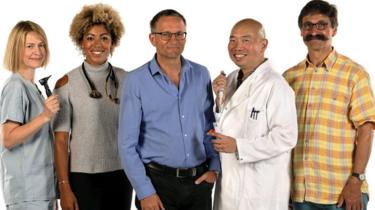MY WORLD OF TRUTH
Wednesday, 12 September 2018
HOW CAN YOU GET ENOUGH IRON FROM YOUR DIET?
 GETTY IMAGES
GETTY IMAGES
Do you often feel tired, short of breath or can you feel you heart beating away inside your chest? Have your friends commented that you look unusually pale?
If so, you may have iron-deficiency anaemia, the world's most common nutritional disorder.
In the UK, it is particularly common among young women.
An analysis by the government's Scientific Advisory Committee on Nutrition (SACN) on iron and health in 2011 indicated 21% of women aged between 19 and 34 had below recommended levels of ferritin (how iron is stored in the body).
I recently suggested to a friend with these symptoms that she might want to get herself checked out by her GP. A blood test revealed she was so anaemic it was surprising she could still walk upstairs. A few iron tablets sorted her out.
It's worth adding that you should talk to your GP if you're considering taking them - you might not need them and your symptoms could be caused by something else.
Where can you get your iron from?
Our bodies can't produce iron, so you have to get it in your diet - whether through foods that naturally contain it or those that have been fortified with iron, such as white bread and breakfast cereal.
The problem is that not all of that iron is in a form you can actually absorb.

 GLENN DEARING
GLENN DEARING
How to get the most iron from your food
- Eat leafy green veg raw or steamed
- But do lightly boil your spinach
- Eat or drink something containing vitamin C with your meal
- Fermented breads are best

Trust Me I'm a Doctor asked nutrition scientist Prof Paul Sharp, from King's College London, to find the foods you should be eating to boost iron levels naturally.
Red meat is particularly rich in the sort of iron bodies find easy to absorb but these days many people are either cutting back on their red-meat consumption or cutting it out altogether.
And there are good sources of iron in dark-green leafy vegetables, such as kale and spinach, and pulses, such as peas and lentils. The problem is you don't absorb as much iron from plant sources as you do from red meat.
Then, there is the iron you can get from fortified bread and breakfast cereals, though again it is not always in a very absorbable form.
To demonstrate this, a neat party trick is to grind up the cereal, add some warm water and you can actually use a magnet to draw the iron filings out of the mush.
Wait for your coffee...
How you prepare your food and what you drink with it can also change how much iron you absorb.
To demonstrate this, Prof Sharp carried out some experiments to mimic human digestion.
The tests mimicked the effect of the enzymes involved in digesting food and the chemical reaction that occurs in human gut cells to show how much iron would be absorbed.
Prof Sharp showed that if you drink orange juice with your fortified breakfast cereal you absorb much more iron than when eating the cereal on its own - because orange juice contains vitamin C, which makes it easier to absorb iron from food.
But, disappointingly, if you drink coffee with your morning bowl of cereal, then that will mean you absorb significantly less iron.
 GETTY IMAGES
GETTY IMAGES
Why? Well, according to Prof Sharp, it's because coffee is full of chemicals called polyphenols that are very efficient at binding to the iron and making that iron less soluble.
So, if a fortified cereal is your breakfast of choice, then having a small glass of orange juice or an orange will help increase your iron uptake. You might also want to consider postponing your morning coffee until at least 30 minutes after you've eaten.
But what if you prefer getting your iron from more natural sources? Raw cabbage is a good source of available iron but we found that steaming it lessened the amount of available iron while boiling reduced it even further.
That's because, like oranges, cabbage is rich in vitamin C - and when you boil it, the vitamin C is released into the cooking water.
So, if you want to get the maximum nutrients from your cabbage, eat it raw (an acquired taste) or steam it.
The same is true of other veggies that contain both iron and vitamin C, such as kale, broccoli, cauliflower and watercress.
But, strangely enough, spinach is completely different. We found that when we boiled the spinach, it actually released 55% more "bioavailable" iron than when eaten raw.
Prof Sharp says: "Spinach has compounds, called oxalates, and they basically trap the iron.
"When we cook spinach, the oxalate is released into the cooking water, and therefore the iron that remains will be more available for absorption."
Finally, what about the bread?
We found the best bread for delivering iron was sourdough bread. That's because wheat contains a chemical called phytic acid that slows down iron absorption by the body.
When sourdough bread is made, the fermentation process breaks down the phytic acid so the iron that remains is more available for absorption.
posted by Davidblogger50 at 07:44

0 Comments:
Post a Comment
<< Home